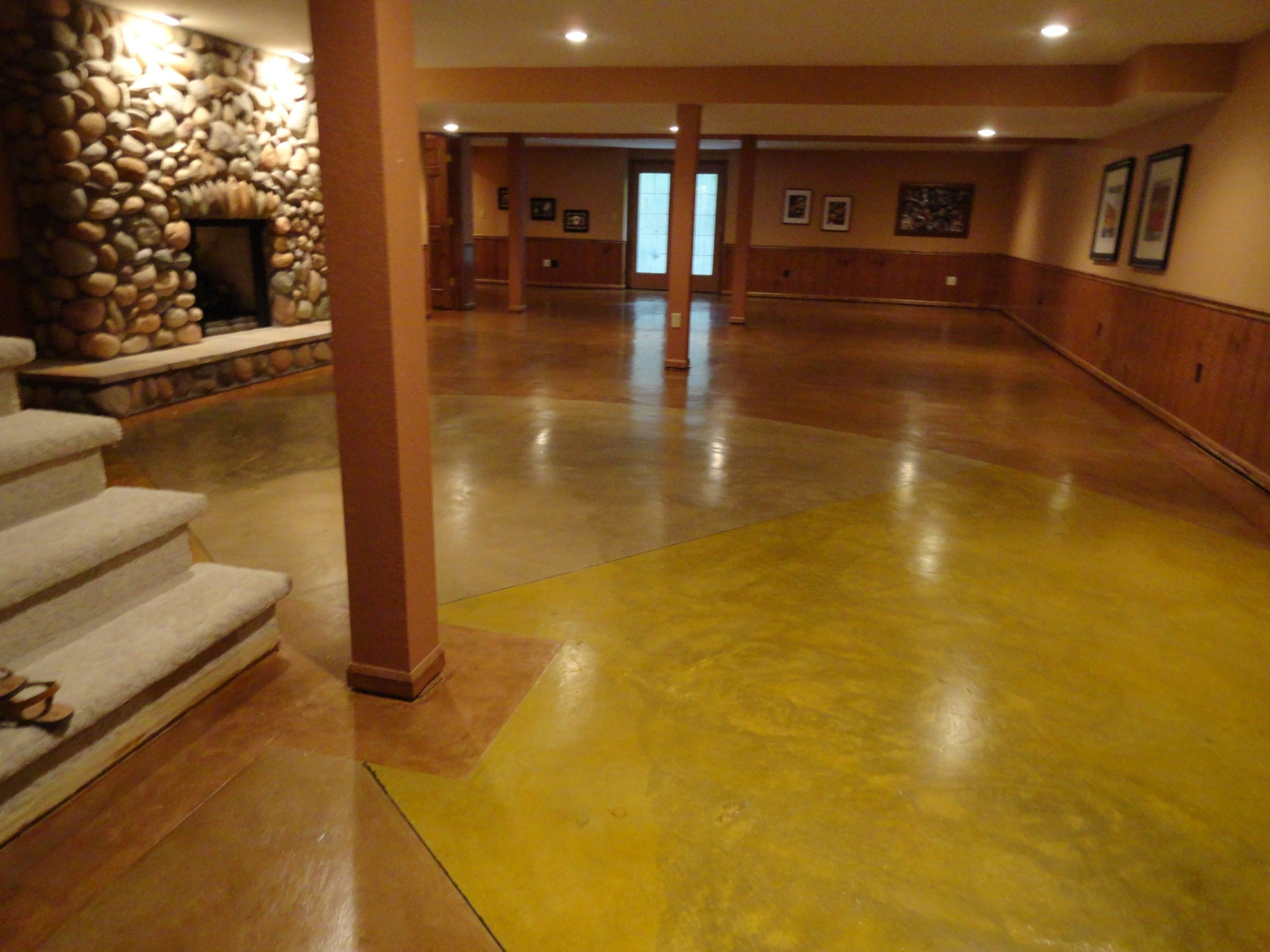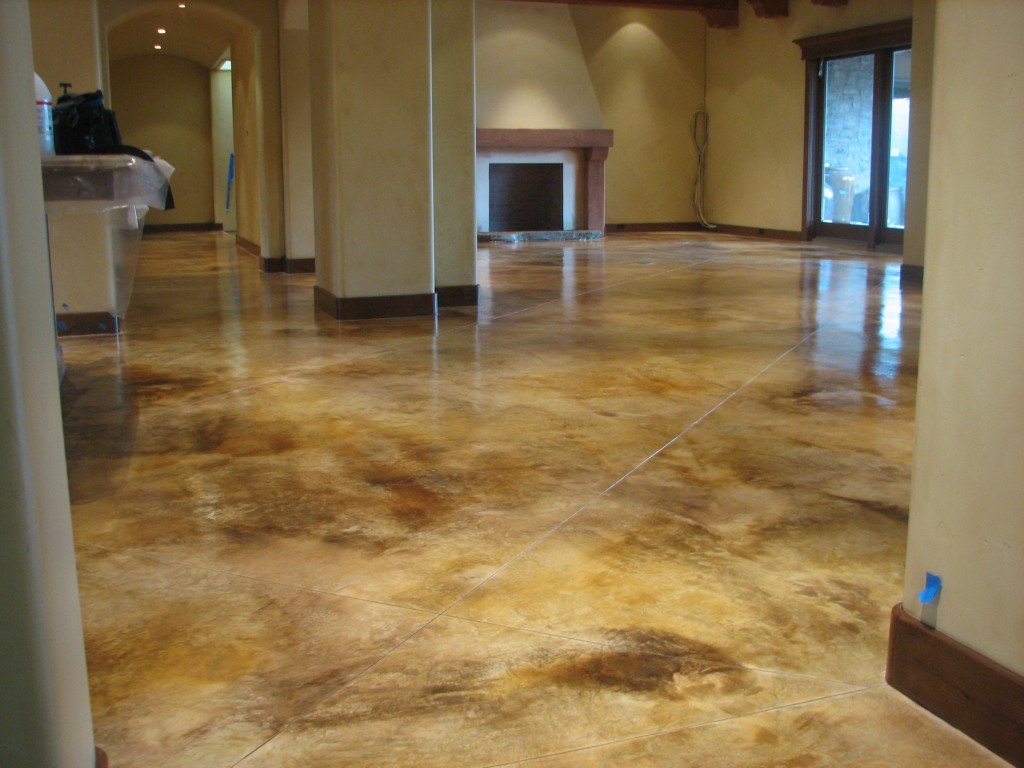All Concerning Stained Concrete: A Comprehensive Overview to Its Benefits and Applications
Stained concrete has actually become a popular option for both domestic and commercial spaces. Its ability to integrate aesthetic allure with usefulness makes it an interesting choice. Numerous staining techniques use a variety of colors and coatings, enabling personalization. However, the benefits extend beyond appearance. Understanding its applications and upkeep requirements is important for anyone considering this functional product. The nuances of stained concrete invite additionally exploration.
What Is Stained Concrete?

Discoloration can be put on different surfaces, including floorings, driveways, and patios, making it a versatile alternative for both interior and outside areas. The treatment can accomplish a variety of looks, from earthy tones to bold, modern layouts. Unlike paint, stained concrete preserves its look over time, as it becomes an integral part of the concrete itself. Generally, stained concrete functions as an efficient approach for changing regular concrete right into aesthetically striking surfaces.
Benefits of Stained Concrete
Stained concrete offers substantial advantages, especially in visual allure and resilience - Austin Stained Concrete Floors. Its vivid colors and distinct patterns boost the aesthetic beauty of any kind of room, making it a prominent option for both household and industrial applications. In addition, the durability of stained concrete assurances that it remains a sensible investment with time, resisting wear and tear
Visual Allure
Among the most compelling benefits of using stained concrete is its exceptional aesthetic appeal. Stained concrete deals an unique and functional appearance that can match various layout styles, from contemporary to rustic. The infusion of lively shades and complex patterns permits homeowners and developers to create personalized surfaces that can improve the overall atmosphere of a space. Unlike traditional flooring choices, stained concrete can resemble the appearance of natural rock or sleek marble, providing an upscale appearance without the connected prices. Additionally, the shiny finish alternatives can reflect light, further lightening up interiors. This versatility makes stained concrete a favored option for both household and industrial applications, where aesthetic impact is extremely important.
Resilience and Long life
The outstanding visual qualities of stained concrete are matched by its amazing sturdiness and longevity - Stained Concrete Floors Austin Texas. Stained concrete surfaces are resistant to put on and tear, making them suitable for high-traffic areas both indoors and outdoors. Their robust nature indicates they can withstand harsh climate condition, including extreme temperatures, rain, and UV exposure, without substantial degradation. Furthermore, stained concrete requires minimal upkeep compared to other flooring choices, as it does not need constant sealing or refinishing. This long life not just lowers replacement costs but also adds to a sustainable building strategy. Overall, stained concrete offers a long-lasting solution that combines aesthetic allure with useful benefits, ensuring its value over time
Different Kinds Of Staining Techniques
Different staining strategies can markedly impact the aesthetic top qualities of concrete surface areas. The three primary approaches consist of acid staining, which reacts chemically with the concrete, water-based discoloration, which offers a broader variety of shades, and overlay discoloration choices that supply a fresh surface. Each method has special characteristics and applications that satisfy different design preferences and project requirements.
Acid Staining Approach
Exactly how can homeowners transform plain concrete surface areas into aesthetically striking attributes? One effective method is acid discoloration, a popular method that enhances the all-natural appeal of concrete. This process entails applying a service of water, hydrochloric acid, and metal salts to the concrete surface. As the acid reacts with the lime existing in the concrete, it creates rich, variegated shades that appear like marble or stone. Acid discoloration is understood for its sturdiness and resistance to fading, making it a long-lasting selection for both indoor and exterior applications. It is important to keep in mind that the outcomes can vary based on the initial concrete color and structure. Appropriate application and sealing are crucial for achieving the desired visual and durability
Water-Based Staining Technique
A prominent choice to acid staining, the water-based discoloration technique uses property owners a functional method to improve concrete surface areas. This method makes use of water-soluble dyes and pigments, permitting a wide variety of colors and finishes. Unlike acid spots, water-based stains can be used to unsealed concrete and supply a simpler clean-up procedure. The results can attain an extra consistent look and can be layered to produce special impacts. Furthermore, water-based stains are usually less hazardous and emit fewer volatile natural compounds (VOCs), making them much more eco-friendly. Homeowners may appreciate the capability to tailor their concrete surfaces with different tones, enabling innovative expression while preserving durability and longevity in their flooring options.
Overlay Discoloration Options
Various overlay staining alternatives exist for property owners seeking to renew their concrete surfaces. One popular selection is acid staining, which responds chemically with the concrete to create rich, variegated shades. One more alternative is water-based staining, offering a wider color palette and much easier application. Additionally, concrete overlays can be incorporated with stencils for detailed styles, boosting aesthetics. For an extra textured surface, homeowners might consider making use of stamped overlays that mimic all-natural products like stone or floor tile. Each method gives distinct advantages, from resilience to customization, permitting for a customized touch. Inevitably, the choice of overlay discoloration depends on the preferred look and the problem of the existing concrete, making sure a revitalized and attractive surface.
Applications of Stained Concrete
Stained concrete deals a flexible service for different applications, boosting both visual appeal and capability. This material is commonly made use of in household, business, and industrial settings, making it a preferred selection among designers and developers. In homes, stained concrete can offer as trendy floor covering or exterior patio areas, giving a sophisticated appearance while remaining durable.
In click here for more info commercial spaces, such as retail stores and dining establishments, stained concrete adds to a contemporary atmosphere and can stand up to heavy foot web traffic. Furthermore, stained concrete is significantly made use of in public rooms like parks and sidewalks, where its ability to mimic natural rock or various other products includes aesthetic rate of interest.
Moreover, stained concrete is excellent for pool decks and driveways, providing a slip-resistant surface that is very easy to keep. In general, the flexibility of stained concrete makes it appropriate for various environments, accommodating varied preferences and demands.
Maintenance and Treatment for Stained Concrete
Appropriate maintenance assures the durability and beauty of stained concrete surfaces. Routine cleaning is vital; using a mild cleaning agent and water with a soft-bristle brush aids eliminate dirt and grime without damaging the finish. It is advisable to stay clear of severe chemicals that can remove the discolor or sealant.
Securing stained concrete is vital for have a peek here defense against dampness, spots, and wear. A top quality sealer ought to be reapplied each to three years, relying on the traffic and direct exposure the surface area withstands. In addition, addressing spills without delay will avoid staining and staining.

Price Factors To Consider for Stained Concrete Projects
When intending a tarnished concrete project, budget factors to consider play a crucial role in identifying the total cost. The expenses connected with stained concrete can differ significantly based on several elements. The dimension of the location to be stained straight affects product and labor prices. Larger rooms will normally call for more resources. Second, the kind of tarnish chosen-- acid-based or water-based-- can affect rates, with acid discolorations often being more pricey. Additionally, the intricacy of the layout, including patterns or numerous shades, can boost labor prices. Preparation work, such as cleaning and grinding the concrete surface, contributes to the initial expenses also. The option between DIY setup and hiring a professional contractor will better influence the budget. Understanding these factors makes it possible for house owners to make informed economic choices about their stained concrete tasks, guaranteeing they achieve the desired visual within their economic means.
Tips for Picking the Right Stained Concrete for Your Room
Choosing the appropriate stained concrete for a particular area entails careful reflection of various variables beyond just budget plan. Initially, one need to evaluate the designated usage of the location. High-traffic areas might need even more long lasting finishes, while ornamental applications can focus on aesthetic appeals.
The color palette is one more vital element; the selected colors must harmonize with existing style and illumination. It's likewise important to take into consideration the surface texture, as smooth surfaces can enhance see this elegance, while distinctive choices may assure safety in damp locations.
Neighborhood climate and ecological problems play a considerable function in the durability and upkeep of stained concrete, affecting the option of sealers and coatings.
Ultimately, seeking advice from with professionals can give important insights customized to certain needs, guaranteeing the option of the perfect stained concrete that aligns with both capability and style.

Frequently Asked Concerns
Can Stained Concrete Be Applied Over Existing Floor Covering?
Stained concrete can undoubtedly be used over existing flooring, gave the surface area is steady and properly prepared. This technique enables a visual upgrade without the need for total elimination of the original floor covering products.
The Length Of Time Does Stained Concrete Last?
Stained concrete can last for decades when properly kept. Factors such as traffic, ecological conditions, and application strategies significantly influence its long life, with many setups staying lively and undamaged for 10 to thirty years.
Is Stained Concrete Slippery When Wet?
Stained concrete can be unsafe when damp, as the finish might develop a smooth surface. However, using non-slip additives or distinctive surfaces can minimize this issue, improving security without endangering the aesthetic charm of the concrete.
Can I Discolor Concrete Myself, or Should I Hire an Expert?
The choice to discolor concrete directly or hire a specialist rest on skill level and project complexity. While do it yourself staining can save cash, experts guarantee suitable outcomes, especially for complex layouts or big surfaces.
What Colors Are Available for Stained Concrete?
The selection of shades readily available for stained concrete includes earthy tones like browns and tans, vivid shades such as reds and blues, and softer tones like pastels. This scheme enables innovative, individualized design choices.